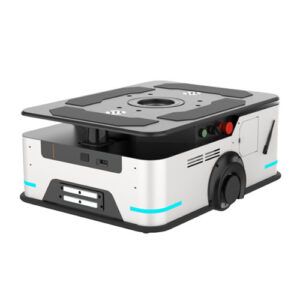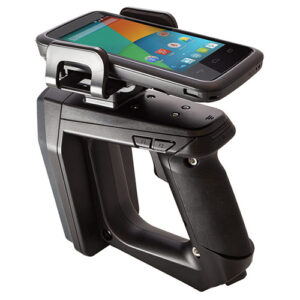Introduction
Effective inventory management is crucial in the food and beverage industry, where factors such as shelf life, storage conditions, and traceability determine product quality and regulatory compliance. Traditional inventory management methods often struggle with inefficiencies, errors, and delays that can lead to financial losses and safety risks. Automated inventory systems address these challenges by optimizing the movement, storage, and monitoring of raw materials and finished goods, ensuring seamless operations.
This article explores how advanced technologies, including autonomous mobile robots (AMRs), RFID tracking, environmental monitoring sensors, and warehouse management systems (WMS), revolutionize warehouse inventory management. These innovations not only improve accuracy but also enhance efficiency, reduce waste, and ensure compliance with industry regulations.
How Automated Inventory Management Works
1. Automated Transport of Inventory 
Autonomous Mobile Robots (AMRs), such as the L300 model, streamline warehouse logistics by automating the transportation of goods. These robots efficiently move inventory between storage, processing, and dispatch areas, minimizing manual labor and reducing the risk of human error. Key benefits include:
- Pathfinding Algorithms: L300 AMRs use intelligent navigation systems to adapt to warehouse layouts dynamically.
- Collision Avoidance: Advanced sensors ensure safe movement around human workers and other obstacles.
- Labor Optimization: Reduces dependency on human labor for repetitive tasks, increasing productivity and lowering operational costs.
2. Tracking with RFID Technology
RFID technology plays a crucial role in real-time inventory tracking and management. RFID tags, such as the A15023-HT, are attached to pallets, crates, or individual products, allowing seamless tracking throughout the warehouse. The RFID system includes:
- Automated Data Capture: RFID readers installed at entry/exit points and storage zones automatically update inventory records.
- Enhanced Accuracy: Minimizes the chances of misplaced or lost items.
- Faster Stock Audits: Reduces the time spent on manual inventory counts and reconciliation.
3. Environmental Monitoring for Storage Conditions
Proper storage conditions are essential for perishable goods in the food and beverage industry. Environmental monitoring sensors, such as the RFRHTemp2000A and CryoTemp, continuously track critical factors like temperature and humidity. This ensures:
- Quality Preservation: Maintains optimal storage conditions to prevent spoilage.
- Automated Alerts: Instant notifications if storage conditions deviate from preset thresholds.
- Regulatory Compliance: Ensures adherence to industry standards for food safety and quality.
4. Integration with Warehouse Management Systems (WMS)
All collected data is integrated into a centralized Warehouse Management System (WMS), such as Neovero, providing a comprehensive inventory overview. The WMS offers:
- Real-Time Inventory Insights: Tracks stock levels, locations, expiration dates, and batch numbers.
- Operational Efficiency: Streamlines restocking, distribution, and order fulfillment processes.
- Automated Reports: Generates detailed reports for analysis and decision-making.
5. Automated Inventory Audits
Periodic audits are essential for maintaining inventory accuracy and preventing shrinkage. Using RFID and barcode scanning technology, automated audits compare physical stock with system records. This results in:
- Reduced Human Error: Eliminates manual data entry mistakes.
- Improved Compliance: Ensures accurate reporting for audits and inspections.
- Lower Shrinkage: Detects discrepancies before they become major financial issues.
6. Real-Time Alerts and Notifications
The Neovero WMS sends instant notifications for critical inventory events, such as:
- Low Stock Alerts: Prevents stockouts by prompting timely reordering.
- Temperature Deviations: Ensures perishable items remain within safe storage conditions.
- Inventory Misplacements: Helps locate misplaced goods quickly, reducing downtime.
7. Mobile Access for Operators 
Warehouse staff can access real-time inventory data through handheld devices like the 3048E or industrial tablets such as the EM-T81X-8G-128G. These devices enable:
- On-the-Go Updates: Operators can check stock levels and update records from anywhere in the warehouse.
- Improved Efficiency: Reduces unnecessary trips to centralized workstations.
- Faster Decision-Making: Enables immediate action based on real-time data.
8. Data Analytics for Warehouse Optimization
Historical inventory data is analyzed to identify trends and improve warehouse efficiency. Benefits of data-driven decision-making include:
- Optimized Storage Layout: Frequently accessed items are positioned near dispatch zones.
- Demand Forecasting: Predicts future inventory needs, reducing excess stock.
- Performance Insights: Identifies bottlenecks and inefficiencies for continuous improvement.
Key Advantages of Automated Inventory Management
1. Improved Accuracy
Automated tracking systems significantly reduce human errors, ensuring precise inventory records.
2. Enhanced Product Quality
By maintaining optimal storage conditions, perishable items remain fresh, reducing waste.
3. Increased Efficiency
AMRs and real-time tracking streamline inventory movement, reducing delays and operational costs.
4. Regulatory Compliance
RFID tracking and environmental monitoring facilitate compliance with food safety and quality regulations.
5. Real-Time Visibility
Warehouse managers can make informed decisions based on up-to-date inventory insights.
6. Scalability
Automated systems adapt to changing inventory volumes and warehouse layouts with ease.
Conclusion
Automated inventory management and monitoring solutions empower the food and beverage industry by ensuring efficiency, accuracy, and compliance. Technologies like AMRs, RFID tracking, environmental sensors, and integrated WMS platforms optimize warehouse operations, minimizing waste and maximizing productivity.
By adopting these innovations, businesses can enhance supply chain resilience, reduce costs, and improve customer satisfaction. As warehouse automation continues to evolve, companies that invest in smart inventory solutions will gain a significant competitive edge in the industry.
sales@logicbus.com | support@logicbus.com | +1 619 616 7350 | Start conversation







